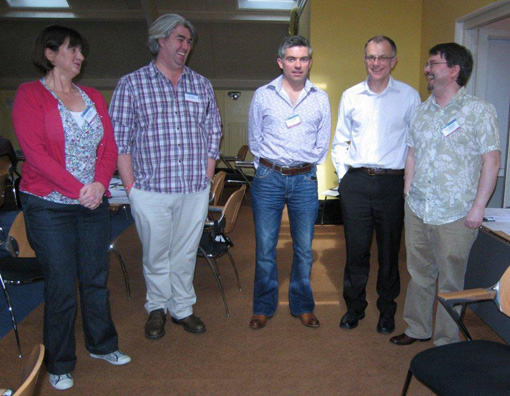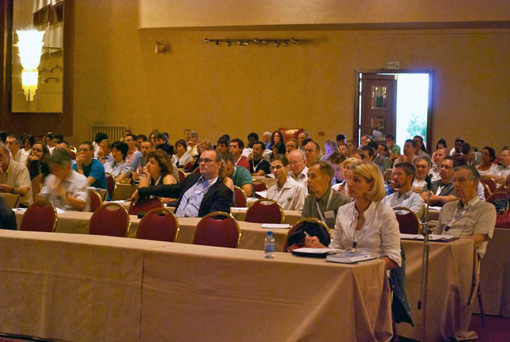
The 18th European Symposium on Quantitative Structure Activity Relationships took place in Rhodes, Greece, on 19-24 September, 2010. The venue was in RODOS PALACE INTERNATIONAL CONVENTION CENTRE. The Symposium was co-organized by the Hellenic Society of Medicinal Chemistry and the Cheminformatics and QSAR Society. The 18th EuroQSAR continued the uninterrupted tradition of holding bi-annual meetings in different European countries since 1973. For the first time the EuroQSAR Symposium was an EFMC sponsored event, in the intent to strengthen its relations with the medicinal chemistry community. In fact, throughout the years, the EuroQSAR meetings always took place in tight connection to the ISMC, usually with one week interval before or after it.
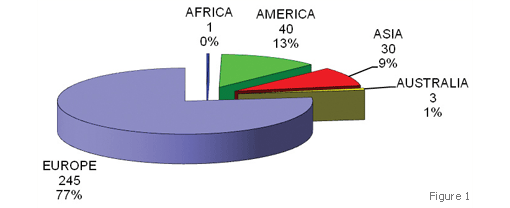
The Symposium has been a very successful event with outstanding speakers and high quality program, embracing the current challenges in the field of QSAR. 320 participants coming from 44 countries around the world (Figure 1) gathered together for 5 days under the sun and brightness of the island of Rhodes and created a vivid and motivating scientific environment and congenial atmosphere inside and outside the sessions and during the social events. Among the participants, 44% were from academia, 34% from Industry, and 22% were students (Figure 2). Moreover, the generosity of sponsors and exhibitors was an important component for the success of the 18th EuroQSAR.
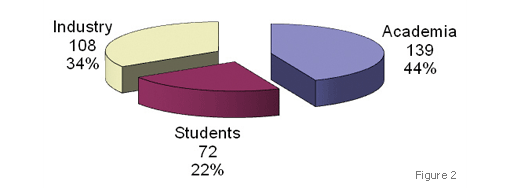
Since its early years (in the midst of ’60s) the evolution of the QSAR field has seen remarkable growth, bringing together the latest ideas in chemistry, biology, mathematics, and computer science, in the aim to predict the biological behavior of compounds directly from their chemical structure and thereupon to support the efforts of the medicinal chemists to synthesize efficient drug candidates. The increasing appreciation and understanding of biological complexity and disease underlying causation, delineates the impact of informatics in all its aspects (cheminformatics, bio-informatics, pharmacoinformatics) in the achievement of this goal and this was reflected in the title of the Symposium “Discovery Informatics and Drug Design”.
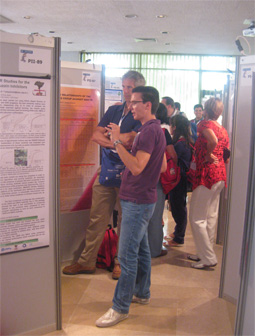 The Symposium started on Sunday afternoon, 19th September 2010, with the opening ceremony, led by the Chair, Prof. Anna Tsantili-Kakoulidou (University of Athens), the Co-Chair, Dr. Dimitris Agrafiotis (Johnson@Johnson) and the Chair of the Cheminformatics and QSAR Society, Prof. Tudor Oprea (University of New Mexico). Prof. Hugo Kubinyi followed with his inaugural lecture on ‘The long road from QSAR to virtual screening... to drugs’, underlining the accomplishments of QSAR but also expressing a strong criticism in regard to its limitations and misuse. This starting point motivated fruitful discussions during the next five days of the Symposium and stimulated the speakers to address the challenges, to defend the achievements and demonstrate the new avenues and perspectives in QSAR. The best practices for model selection and validation as well as the development of more accurate and representative molecular descriptors were among the topics addressed during the Symposium. Chemical space navigation, virtual screening, activity cliffs and scaffold effect exploitation in biological oriented synthesis were core highlights and were discussed as tools for ligand design and lead generation. Emphasis was further extended to multi-parameter drug optimization in order to balance potency, ADME, physico-chemical properties, and safety endpoints. In this aspect, the key role of metabolism in drug efficacy and safety, in silico evaluation of protein binding and permeability, as well as modeling drug-transporter interactions were discussed in relevant sessions. The multi-target concept (expressed also by the term ‘poly-pharmacology’) was another dominant high spot, guiding the shift of the QSAR dream from the study of a single target to the consideration of a series of targets and anti-targets and from modeling of biological activity to multi-level modeling of complex relationships for the prediction of clinical outcomes. Observational data obtained through text mining of patient records and public sources may support the assessment of the in silico target profiling and drug repurposing as suggested by some speakers. Predictive toxicology has its own position in addressing pre-competitive bottlenecks in pharmaceutical R&D and a number of lectures were devoted to this topic, emphasizing the challenge to translate from in silico predictions to in vitro to in vivo data. Next to drugs, the design of potent crop protection compounds constitutes an important issue, strongly related to the first steps of QSAR history. Computational Strategies in agrochemical research were discussed in a relevant session.
The Symposium started on Sunday afternoon, 19th September 2010, with the opening ceremony, led by the Chair, Prof. Anna Tsantili-Kakoulidou (University of Athens), the Co-Chair, Dr. Dimitris Agrafiotis (Johnson@Johnson) and the Chair of the Cheminformatics and QSAR Society, Prof. Tudor Oprea (University of New Mexico). Prof. Hugo Kubinyi followed with his inaugural lecture on ‘The long road from QSAR to virtual screening... to drugs’, underlining the accomplishments of QSAR but also expressing a strong criticism in regard to its limitations and misuse. This starting point motivated fruitful discussions during the next five days of the Symposium and stimulated the speakers to address the challenges, to defend the achievements and demonstrate the new avenues and perspectives in QSAR. The best practices for model selection and validation as well as the development of more accurate and representative molecular descriptors were among the topics addressed during the Symposium. Chemical space navigation, virtual screening, activity cliffs and scaffold effect exploitation in biological oriented synthesis were core highlights and were discussed as tools for ligand design and lead generation. Emphasis was further extended to multi-parameter drug optimization in order to balance potency, ADME, physico-chemical properties, and safety endpoints. In this aspect, the key role of metabolism in drug efficacy and safety, in silico evaluation of protein binding and permeability, as well as modeling drug-transporter interactions were discussed in relevant sessions. The multi-target concept (expressed also by the term ‘poly-pharmacology’) was another dominant high spot, guiding the shift of the QSAR dream from the study of a single target to the consideration of a series of targets and anti-targets and from modeling of biological activity to multi-level modeling of complex relationships for the prediction of clinical outcomes. Observational data obtained through text mining of patient records and public sources may support the assessment of the in silico target profiling and drug repurposing as suggested by some speakers. Predictive toxicology has its own position in addressing pre-competitive bottlenecks in pharmaceutical R&D and a number of lectures were devoted to this topic, emphasizing the challenge to translate from in silico predictions to in vitro to in vivo data. Next to drugs, the design of potent crop protection compounds constitutes an important issue, strongly related to the first steps of QSAR history. Computational Strategies in agrochemical research were discussed in a relevant session.
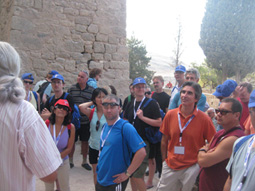 Summarizing the Symposium scientific program, there were 14 plenary lectures (+ the inaugural lecture), 6 keynote lectures and 36 oral presentations as well as 225 posters, divided in two poster sessions. Among the posters, four were selected as short oral communications and were presented in a young researchers forum. The authors received poster prizes, one sponsored by Sunset Molecular -1st prize, awarded to Dr. Juliana Cheleski from Brazil- and two by Molecular Informatics/Wiley, Ltd - one awarded to Dr. Andrea Volkamer from Germany and one shared between Dr. Sun Choi , Korea and Dr. George Lamprinidis, Greece.
Summarizing the Symposium scientific program, there were 14 plenary lectures (+ the inaugural lecture), 6 keynote lectures and 36 oral presentations as well as 225 posters, divided in two poster sessions. Among the posters, four were selected as short oral communications and were presented in a young researchers forum. The authors received poster prizes, one sponsored by Sunset Molecular -1st prize, awarded to Dr. Juliana Cheleski from Brazil- and two by Molecular Informatics/Wiley, Ltd - one awarded to Dr. Andrea Volkamer from Germany and one shared between Dr. Sun Choi , Korea and Dr. George Lamprinidis, Greece.
In the frame of the Symposium, the Cheminformatics and QSAR Society meeting took place and the status of the Society and its future perspectives were discussed. In this meeting, chaired by Tudor Oprea, Dr Ismael Zamora was announced as the 2010 Hansch award recipient.
Selected papers presented in the Symposium appear in a EuroQSAR 2010 special issue of Molecular Informatics (Vol. 30, issue 2-3, 2011).
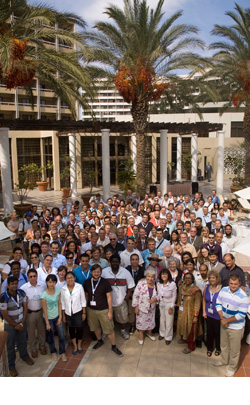 The in silico approaches have become more important than ever in reducing attrition rate and accelerating drug discovery and development and are currently implemented in many recent calls for proposals by healthcare funding agencies. In this aspect, the 18th EuroQSAR Symposium made a significant contribution to the medicinal chemistry community, providing new ideas, new methodologies, and new ways of thinking by integrating a holistic multi-level view in ligand design, exploiting and rationalizing the maximum of the available vast information. Further to the impact of informatics in shaping the future avenues of QSAR, knowledge management is now emerging as particular critical to tackle this enormous increase in the size, complexity and noise level of the data sets. This issue was clearly outlined during the Symposium and in the closing round table discussion, thus, creating the bridge to the 19th EuroQSAR Symposium, entitled Knowledge Enabled Ligand Design, which will take place in Vienna, August 26-31, 2012.
The in silico approaches have become more important than ever in reducing attrition rate and accelerating drug discovery and development and are currently implemented in many recent calls for proposals by healthcare funding agencies. In this aspect, the 18th EuroQSAR Symposium made a significant contribution to the medicinal chemistry community, providing new ideas, new methodologies, and new ways of thinking by integrating a holistic multi-level view in ligand design, exploiting and rationalizing the maximum of the available vast information. Further to the impact of informatics in shaping the future avenues of QSAR, knowledge management is now emerging as particular critical to tackle this enormous increase in the size, complexity and noise level of the data sets. This issue was clearly outlined during the Symposium and in the closing round table discussion, thus, creating the bridge to the 19th EuroQSAR Symposium, entitled Knowledge Enabled Ligand Design, which will take place in Vienna, August 26-31, 2012.
Anna Tsantili-Kakoulidou
Department of Pharmaceutical Chemistry
School of Pharmacy
University of Athens
Athens
Greece
Tel: +30 210 7274530
Fax: + 30 210 7274747
e-mail: tsantili@pharm.uoa.gr
_________________________________________________________________
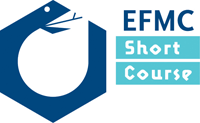 The third EFMC Short Course Principles and Applications of in vitro pharmacology in Drug Discovery for Medicinal Chemists has become a major success. From 10 to 13 April 45 participants came to the small castle Oud Poelgeest near Leiden in the Netherlands, which has become the venue for these courses.
The third EFMC Short Course Principles and Applications of in vitro pharmacology in Drug Discovery for Medicinal Chemists has become a major success. From 10 to 13 April 45 participants came to the small castle Oud Poelgeest near Leiden in the Netherlands, which has become the venue for these courses.
Many aspects of modern in vitro pharmacology were handled by an enthusiastic teaching tem of six, headed by Michael Trevethick.The participants rated both the teachers and the information they provided very high. The open interactive atmosphere was appreciated much. The including of break out sessions - tutorials with questions, problems from the preceding talks- was extremely successful. The availability of the teachers throughout the complete course was applauded by the participants.
The venue was at is best in a sunny period in this spring. Lots of flowers, pleasant temperatures. On one of the evenings all participants joined a guided walk through historical parts of Leiden, the birthplace of Rembrandt, the university “of” Van der Waals, the city from which the Pilgrim fathers departed towards the United States.
Te EFMC thanks all teachers who contributed without asking for a fee; great!
The EFMC has decided to organize from 2011 on two short courses each year. The next course is scheduled for 7-9 December 2011.
